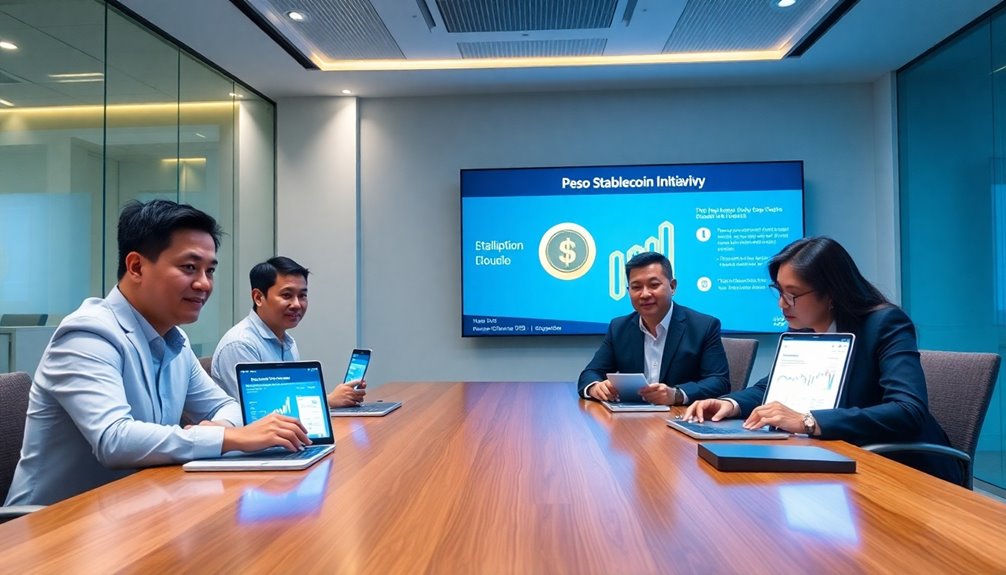Four major Philippine banks, including UnionBank and Rizal Commercial Banking, are launching the PHPX stablecoin initiative, set to debut between May and July 2025. This stablecoin, backed by the peso, aims to enhance cross-border payments and financial inclusion, particularly for the unbanked. Developed by Just Finance using Hedera's decentralized ledger technology, it promises real-time transactions while adhering to strict regulatory guidelines. The initiative looks to provide a stable digital currency solution, reducing volatility and increasing liquidity in the market. Keep exploring to discover how this initiative could reshape the Philippine financial landscape.
Key Takeaways
- UnionBank, Rizal Commercial Banking, Cantilan Bank, and Rural Bank of Guinobatan are collaborating to launch the PHPX stablecoin in the Philippines.
- The PHPX stablecoin aims to enhance financial inclusion and facilitate cross-border payments with real-time transaction capabilities.
- Developed by Just Finance, the PHPX utilizes Hedera decentralized ledger technology to ensure transparency and security in transactions.
- The initiative is designed to comply with Basel Committee guidelines and is pending approval from the Bangko Sentral ng Pilipinas.
- PHPX will operate on a permissioned DLT network, maintaining segregated trust accounts primarily holding government bonds.
Stablecoin Fundamentals

Stablecoins serve as a bridge between the world of cryptocurrencies and traditional fiat currencies, providing a stable digital asset for everyday transactions.
These cryptocurrencies are pegged to assets like the U.S. dollar, ensuring their value remains stable. This characteristic makes them ideal for everyday use and cross-border payments, minimizing the price volatility often found in unpegged cryptocurrencies.
You can choose from various types of stablecoins, such as fiat-collateralized, algorithmic, or commodity-backed options, each offering different benefits. Fiat-collateralized stablecoins maintain reserves of fiat currency, which helps ensure their stability.
They enhance liquidity in the crypto markets, allowing quick trades without converting to fiat. Plus, their global accessibility means you can transact any time, anywhere, making stablecoins a practical choice for digital commerce and decentralized finance applications.
Peso-Backed Digital Currency Launch

The upcoming launch of a peso-backed digital currency marks an exciting development in the realm of stablecoins, particularly for the Philippines. Scheduled between May and July 2025, this initiative involves UnionBank, Rizal Commercial Banking Corporation, Cantilan Bank, and Rural Bank of Guinobatan, with the Singapore-based Just Finance developing it. Utilizing the Hedera decentralized ledger technology, the stablecoin aims to enhance cross-border payments and financial inclusion. It will allow real-time payments, making transactions like tuition fees easier. With compliance to Basel Committee guidelines and awaiting Bangko Sentral ng Pilipinas approval, PHPX is designed to be secure and bankruptcy remote. This innovation could streamline the remittance process, impacting the economy positively as part of a growing stablecoin market. The collaboration among four banks signifies a shift towards innovative financial instruments in the region.
Transaction Process Explained

How does the transaction process for the peso-backed PHPX stablecoin work?
First, you initiate a transfer by instructing a smart contract to move the PHPX stablecoin. The smart contract then verifies the transaction against the PHPX protocol, with network participants validating it and potentially charging fees.
Once verified, the transaction is recorded on a public ledger. Next, it undergoes real-time auditing to maintain compliance and security, which is essential due to the bank-backed security of PHPX.
After confirmation on the blockchain, the PHPX can be converted into another currency for cross-border payments.
Lastly, network fees are deducted, the PHPX is transferred to the recipient's account, and their balance updates, ensuring a secure and transparent process throughout.
Pros and Cons Overview

While considering the PHPX stablecoin, it's essential to weigh both its advantages and disadvantages.
On the plus side, PHPX offers price stability, maintaining its value against the Philippine peso, which reduces volatility for daily transactions. It integrates well with decentralized finance, providing liquidity and versatility for various applications. Moreover, it enhances cross-border remittances, making payments faster and more efficient while promoting financial inclusion. Additionally, PHPX can serve as a stable medium for decentralized finance applications, further expanding its utility and appeal.
However, the PHPX stablecoin also has risks. There's a de-pegging risk, where market fluctuations could affect its value. Centralization raises concerns about a single point of failure, and trust in the issuer's reserve management is crucial.
You need to consider these factors when evaluating PHPX's potential impact on your financial activities.
Stablecoin vs. Fiat Currency

As you explore the differences between stablecoins and fiat currencies, you'll notice that stablecoins offer unique advantages in value stability and transaction efficiency.
Unlike fiat currencies, which are often impacted by inflation and economic fluctuations, stablecoins are backed by reserves, ensuring a consistent value. They facilitate seamless cross-border payments, often with lower transaction costs and faster settlement times, sometimes only taking minutes. Additionally, fiat-backed stablecoins emphasize transparency and regular audits to build trust among users.
In contrast, fiat currencies can be limited by geography and banking hours. Stablecoins enhance global accessibility, empowering individuals without relying on traditional banking systems.
They also serve as a safeguard against devaluation, providing monetary stability for users. Overall, stablecoins present a compelling alternative to fiat currencies in today's interconnected financial landscape.
Regulatory Compliance Hurdles

Navigating regulatory compliance hurdles is crucial for the PHPX stablecoin's success in the financial landscape. You'll see that it operates on a permissioned DLT network, aligning with Basel Committee rules to classify it as a low-risk asset. This choice helps minimize capital requirements while ensuring the stablecoin meets the Bangko Sentral ng Pilipinas (BSP) standards and European MiCAR regulations. The PHPX will also maintain segregated trust accounts, primarily holding government bonds to provide a secure backing, while a small cash balance ensures liquidity. Operating within the BSP's Regulatory Sandbox allows for controlled assessments, ensuring consumer protection and stability. Notably, this initiative is part of the BSP's broader efforts to regulate stablecoin issuance, which could lead to enhanced financial system integration. Ultimately, successful compliance will pave the way for broader adoption and integration into the financial system.
Recent Adoption by Financial Institutions

Recent developments in the adoption of the PHPX stablecoin by financial institutions signal a transformative shift in the landscape of digital currencies.
UnionBank, Rizal Commercial Banking, Cantilan Bank, and Rural Bank of Guinobatan have partnered with Singapore-based Just Finance to create a robust governance structure for PHPX, which will operate on the Hedera Distributed Ledger Technology network. This initiative primarily aims to streamline cross-border payments, facilitating remittances for the $40 billion sent by overseas workers in 2024.
The banks will act as initial liquidity providers, with plans to support multi-currency exchanges. As part of this effort, PHPX is designed to enhance financial inclusion by providing accessible payment solutions for users in the Philippines.
With UnionBank's experience in blockchain technology, the PHPX initiative promises security and efficiency for future financial transactions, aligning with global trends in stablecoin adoption.
User Education on Stablecoins

User education on stablecoins is crucial for individuals looking to navigate this evolving financial landscape effectively. You need to understand the different types of stablecoins, such as fiat-collateralized and crypto-collateralized, along with the risks they carry, including de-pegging and counterparty risks. Being aware of regulatory compliance and transparent reserve management is essential for making informed decisions. Engaging in workshops and webinars can provide hands-on training and real-time insights. Utilizing interactive tools will help you grasp complex concepts easily. The introduction of PHPX stablecoin reflects the growing trend of stablecoin adoption in the Philippines, emphasizing the need for user education in this space.
Frequently Asked Questions
How Can Individuals Participate in the Peso Stablecoin Initiative?
You can participate in the peso stablecoin initiative by opening an account with one of the participating banks, like UnionBank or RCBC.
Once you've got an account, you can deposit or send PHPX coins directly to it, a GCash wallet, or even pick up cash over-the-counter.
This seamless integration with blockchain technology allows you to make transactions securely for both domestic and cross-border payments, enhancing your financial options.
What Are the Security Measures for the Stablecoin?
To ensure the security of a stablecoin, you should focus on several key measures.
Start with private key management and protect your seed phrases to prevent unauthorized access.
Regular audits and vulnerability scans will help identify weaknesses.
Engage in code reviews and penetration testing for smart contracts.
Lastly, invest in employee training to foster cybersecurity awareness, teaching them to recognize phishing attempts and maintain secure practices to safeguard the system.
Will the Stablecoin Earn Interest for Users?
While traditional savings accounts offer low interest rates, the stablecoin might provide better earning potential.
You'll benefit from liquidity providers facilitating currency swaps, which could generate yield. Market demand and regulatory compliance will shape the interest rates available to you.
As adoption grows, so could your earnings, especially if you engage in frequent transactions.
Ultimately, your active participation and the stablecoin's design will determine how much interest you earn.
What Happens if a Bank Fails While Holding Stablecoins?
If a bank fails while holding stablecoins, you could face several risks.
Your stablecoins might become illiquid, especially if the reserves are tied up in the bank's assets.
However, if reserves are kept in segregated trust accounts, they could remain safe from bankruptcy proceedings.
Still, there's a chance of reputational damage to the bank, which might affect your confidence in future stablecoin transactions.
Always ensure you understand the bank's financial health before investing.
Can the Peso Stablecoin Be Exchanged for Cash?
Exchanging the Peso stablecoin for cash is like turning a key in a lock—it opens up new possibilities.
Yes, you can convert it into cash through various channels. Just deposit it into your bank account, transfer it to a GCash wallet, or opt for cash pickup at designated locations.
This flexibility means you can access your funds easily, making transactions smoother and more convenient in today's fast-paced digital landscape.
Conclusion
So, while four Philippine banks are strutting around with their shiny new peso stablecoin, you might be wondering if this is the future or just a high-tech version of Monopoly money. Sure, it promises faster transactions and all that jazz, but let's not forget the regulatory hurdles that might trip it up like a toddler on roller skates. Who knew digital currency could be such a circus? Just remember, folks: not all that glitters is gold—sometimes it's just a peso!









